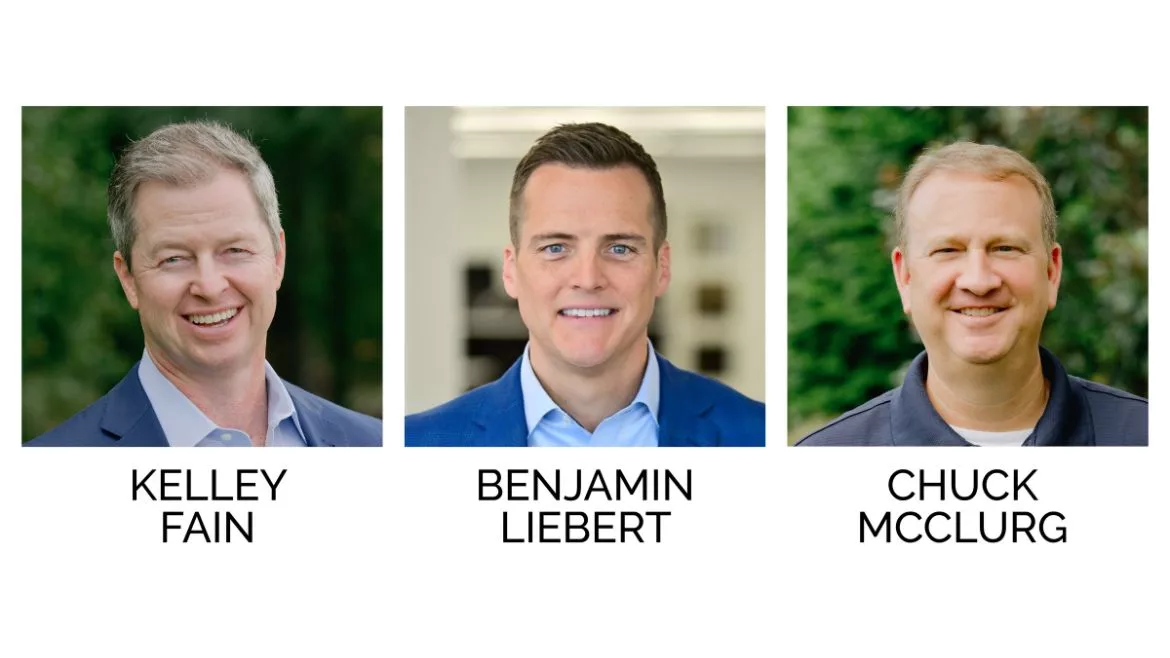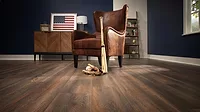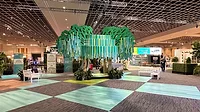Shaw Presidents Reveal Direct Benefits for Retailers: Supply Chain Resilience, Faster Response Times, Turf Growth

Shaw division presidents Kelley Fain (Commercial), Benjamin Liebert (Residential), and Chuck McClurg (Turf) reveal how their expanded leadership roles translate into practical advantages for channel partners. Photo: Shaw.
Shaw Industries' recent organizational changes are already delivering tangible benefits to flooring retailers and specifiers. In exclusive Floor Trends & Installation interviews, division presidents Benjamin Liebert (Residential), Kelley Fain (Commercial), and Chuck McClurg (Turf) reveal how their expanded leadership roles translate into practical advantages for channel partners—from supply chain stability to faster project turnarounds to entirely new revenue opportunities.
With decision-making now closer to the market, these leaders are implementing changes that directly address dealer pain points: inventory concerns, tight installation timelines, and the need for business diversification. Their insights reveal a company restructured not just for internal efficiency, but specifically to better support the professionals who sell and specify Shaw products daily.
RESIDENTIAL
Floor Trends & Installation: As head of Shaw Residential, what specific advantages will flooring retailers and installers see from this organizational realignment in 2025?
Benjamin Liebert: In our residential business, we brought manufacturing and operations closer to both our teams and our customers—enabling us to respond faster and more effectively to their needs. This shift makes us more accountable and better equipped to deliver the right products, in the right places, at the right times. It is all about supporting our retail partners with solutions that align with where the market is headed and what consumers are looking for next.
Floor Trends & Installation: Many flooring dealers are concerned about balancing domestic and imported products. What assurances can you give retailers about Shaw Residential's supply chain resilience compared to competitors who rely more heavily on imports?
Liebert: We believe that the combination of our robust supply chain and domestic manufacturing is the key to success in this dynamic market. Internationally, we source from multiple global locations to reduce dependency on any single region. Domestically, we proactively use alternative transportation routes and regional hubs to maintain product flow. We have also invested over $1 billion in domestic manufacturing over the past five years. A dual strategy that allows us to leverage our entire portfolio is what sets us apart and best positions us to serve customers regardless of how the market shifts.
Floor Trends & Installation: You've positioned carpet as part of a broader flooring ecosystem rather than an isolated category. How should flooring professionals present this holistic approach to consumers when showcasing your complete product line?
Liebert: Flooring is a foundational part of what helps make a house feel like a home, and we need to deliver products that help each consumer bring to life the home they want with a variety of products, including carpet, whether it’s broadloom or rugs and runners. Consumers do not think about flooring categories, they think about their vision for their home and how they and their family or guests will feel in that home, as well as how well that look and feel will stand up over time. As an industry, the more we can put ourselves in that mindset versus thinking narrowly by product category, the better we can serve consumers. In the broader building products space, flooring has traditionally created less value than other segments, and we think it deserves more because it is so important to the overall feel of the home. This is, in part, why we are focused on building stronger brands. Brands can play a huge role in driving consumer awareness and loyalty to our products. They also create an avenue to highlight performance, comfort, and design that supports real, everyday living.
Floor Trends & Installation: With the aging housing stock creating potential for remodel-driven growth, what specific residential product innovations are you developing that will help retailers capitalize on this trend?
Liebert: As we look at the opportunities created by the aging housing stock and the potential for remodel-driven growth, our focus is on providing residential product innovations that help our retail partners meet evolving consumer needs. Each of our brands is strategically positioned to address specific consumers and what kind of home they are looking to create, which in turn creates different flooring demands in the market—whether it is performance, design, or a combination of both.
For example, Shaw Floors’ Pet Perfect line is designed to address the growing need for durability and ease of maintenance, particularly in homes with pets. With features like advanced stain protection, fade resistance, and easy cleanability, this line gives consumers confidence in their flooring choices, making it an ideal part of the solution for remodel projects where pets are part of the household. The breadth of Shaw Floors' offerings also means that our consumers and customers can trust this brand to meet different needs and wants throughout the house and in each of its spaces.
Anderson Tuftex, on the other hand, focuses on high-end design, appealing to consumers who are looking to make their home their sanctuary. By combining sophisticated aesthetics with a strong sustainability narrative, Anderson Tuftex is well-positioned for remodels where style and environmental responsibility are priorities.
COREtec brings a unique combination of performance and design, meeting the demand for innovative, high-quality solutions that perform in real-world conditions while still making a design statement. Innovations like Soft Step™ address the need for quieter, more comfortable living spaces, which is becoming increasingly important in both new builds and remodels alike.
Ultimately, we are committed to ensuring our products align with where the market is heading. By offering a comprehensive range of solutions, we empower our retail partners to capitalize on remodel-driven growth, support their customers’ evolving needs, and strengthen their position in a competitive marketplace.
Floor Trends & Installation: With the evolving needs of independent local businesses in 2025, how are you adapting your commercial division's approach to better serve these Main Street customers?
Liebert: We are committed to helping our retail partners grow by supporting their expansion beyond residential and into the Main Street commercial segment. As part of Shaw Industries’ broader commercial strategy, Philadelphia Commercial is focused on delivering meaningful value at the local level—empowering our retailers to meet the needs of Main Street businesses in their communities to help create comfortable spaces for working, playing, and gathering. Our approach is all about equipping independent businesses with the right products, tools, and support they need to stay competitive, meet evolving customer demands, and strengthen their presence in the commercial market.
COMMERCIAL
Floor Trends & Installation: How will your new organizational structure affect your relationships with architects and designers who specify commercial flooring?
Kelley Fain: Shaw’s new business-unit-led structure empowers leaders with full accountability for strategy, performance, and operations—including manufacturing—within their respective businesses. This shift enables faster decision-making that’s closer to the customer, enhancing responsiveness and support for the design community.
By increasing internal connectivity and alignment across teams, this structure creates more direct pathways for market feedback—including from architects and designers—to inform decision-making. It encourages collaboration, builds trust across functions, and helps us work from the market back to ensure we stay agile and responsive while maintaining operational excellence. This unified approach allows us to better anticipate and meet the evolving needs of those specifying our products.
Floor Trends & Installation: Shaw has recently invested $90 million to expand domestic resilient flooring. How will this affect your product availability timelines for dealers?
Fain: Shaw’s $90 million investment in expanding domestic resilient flooring manufacturing at Plant RP is a strategic move to support faster product availability and deliver enhanced performance features for our dealer network. By nearly doubling our production capacity by 2026, we’ll be able to significantly reduce lead times, deepen inventory, and increase responsiveness to market demands.
This expansion also creates new product capabilities—smaller production runs, new embossing textures, added dimensional stability for loose lay applications, and a broader range of sizes—allowing us to offer even more tailored solutions for commercial environments.
Equally important, this facility reflects our ongoing leadership in sustainability. Through our reclamation program at Plant RP, we’re the only circular manufacturer in the industry reclaiming used resilient flooring and turning it back into new product—supporting both performance and environmental responsibility.
Floor Trends & Installation: Which commercial sectors present the greatest opportunity for flooring contractors in 2025?
Fain: The healthcare sector is increasingly focused on infection control, durability, and maintenance, as well as patient-centered design. Flooring solutions that address these needs are in high demand.
Educational institutions are prioritizing sustainability, acoustics, safety, and student-focused design to create high-performing learning environments. The focus in 2025 will be on higher education, with significant growth projected in this segment.
The hospitality sector is experiencing growth in remodeling projects and a focus on brand consistency. Flooring solutions that offer aesthetic appeal and durability are key. Brand conversations and renovations are at record highs, with Shaw Contract included in 80 brand standards.
Floor Trends & Installation: Commercial installers face unique challenges with made-to-order products and tight installation timelines. How are your teams addressing these constraints to better support installation professionals?
Fain: Supporting tight timelines is a priority across Shaw’s entire commercial division—from manufacturing to our brand teams. Our robust U.S. manufacturing footprint for both resilient and carpet products, combined with deep inventory capabilities, enables quick-ship options and short lead times to better meet evolving project demands.
Teams are also consistently addressing project timeline constraints through new product innovations and launches, from pressure-sensitive adhesives (PSA 4252) that allow for longer working times that supports accelerated construction schedules and works across both carpet tile and LVT.
In addition, we’re expanding our technical services team for greater jobsite support and enhancing product performance—such as improved moisture tolerance for new slabs—to better align with the realities of today’s installations.
Floor Trends & Installation: As commercial projects become more complex, how are you enhancing training and education programs to ensure dealers and contractors can effectively promote and install your innovative commercial solutions?
Fain: As commercial projects grow in complexity, we’re focused on delivering in-market, hands-on training tailored to the real-world needs of dealers—whether that’s sales support, product education, or technical installation guidance. These customized programs are shaped through discovery conversations with customers and dealer partners to ensure relevance and impact.
Our investment in regional technical resources allows us to bring training directly to the field and offer jobsite support when needed, ensuring successful installations. While we’re continuously exploring additional in-market education and leadership development opportunities that support evolving dealer needs, we’re already equipped today to deliver brand-specific training that empowers our partners to confidently promote and support complex commercial solutions.
Floor Trends & Installation: With Shaw's EcoWorx products WELL certification, how should commercial flooring dealers leverage this achievement when working with clients who prioritize wellness-oriented spaces?
Fain: The Works with WELL designation for our EcoWorx carpet tile products illustrates that all EcoWorx carpet tile products from Shaw Contract, Patcraft and Philadelphia Commercial can contribute to the International WELL Building Institute’s WELL Building Certification.
Commercial flooring dealers can leverage the Works with WELL mark to help customers that are pursuing the WELL Certification for their space or building identify products that can contribute to key material health and indoor air quality features in the building standard. The seal indicates that these products have essentially been pre-screened to align with six WELL Standard features.
But the Works with WELL designation is valuable even for those not pursuing WELL certification for their space or building. The seal illustrates that the product meets stringent material health and indoor air quality criteria set by a well-respected global organization, providing customers focused on health and wellbeing with assurance in their purchase decision.
TURF
Floor Trends & Installation: Turf represents a growing opportunity for traditional flooring dealers looking to diversify. Tell us about the opportunity.
Chuck McClurg: The synthetic landscape turf market presents a significant opportunity for flooring retailers to expand their business. This segment has grown steadily over the years and is expected to continue to see seven to 10 percent growth over the next few years.
While synthetic turf has been popular for residential and commercial use for some time in Arizona, California, New Mexico, Florida, Texas and the Carolinas, we’re now seeing demand for this versatile product throughout the country. It’s particularly popular in drought-prone regions where water conservation is a priority, but it’s also in-demand for its ease of maintenance. No watering, no fertilizing, no mowing. This is particularly appealing for multifamily and commercial spaces that want to create a lush appearance but avoid significant upkeep.
Innovation in landscape turf has been instrumental in the growth of this product category. Today’s synthetic turf looks more like natural grass than ever before, and innovations even allow you to create the appearance of intricate mow patterns in the lawn. And technological advancements in Shaw’s pet-friendly turf products – such as flowthrough backing and canine sand – help keep surfaces clean and neutralize odors, making synthetic turf ideal for pet areas.
Geofill, an infill made with coconut fibers, delivers outstanding performance and sustainability attributes that today’s customers desire. Its unique properties allow it to absorb water, similar to natural soil, released when the sun warms the ground. This cooling mechanism helps maintain a lower temperature on the surface, making it more comfortable. Additionally, Geofill provides a stabilized layer between the turf fibers, mimicking the impression of real grass. This ensures a natural feel underfoot and enhances the overall aesthetic appeal of outdoor spaces.
Shaw offers a wide range of turf solutions including sophisticated athletic fields; agility turf for spaces like batting cages and porches that have a glue-down application; and landscape turf where the installation is different than a flooring installation.
Flooring retailers can easily offer turf products for agility areas from our Philadelphia Commercial brand to expand their portfolio. For those looking to pursue the bigger opportunity in landscape turf, a retailer can take one of two approaches. If retailers want to provide the same full-service capabilities in turf as they do in carpet, a retailer could choose to build a turf specific crew within their business or identify an installation partner and subcontract the installation.
The key to success is targeting landscape professionals (the pro) through marketing efforts. Understanding that audience, their priorities and pain points is important and a new frontier for most flooring retailers. Shaw is the ideal partner because of our understanding of this key audience, our expansive portfolio of synthetic landscape turf solutions, and our commitment to innovation and sustainability in all we do.
Looking for a reprint of this article?
From high-res PDFs to custom plaques, order your copy today!






